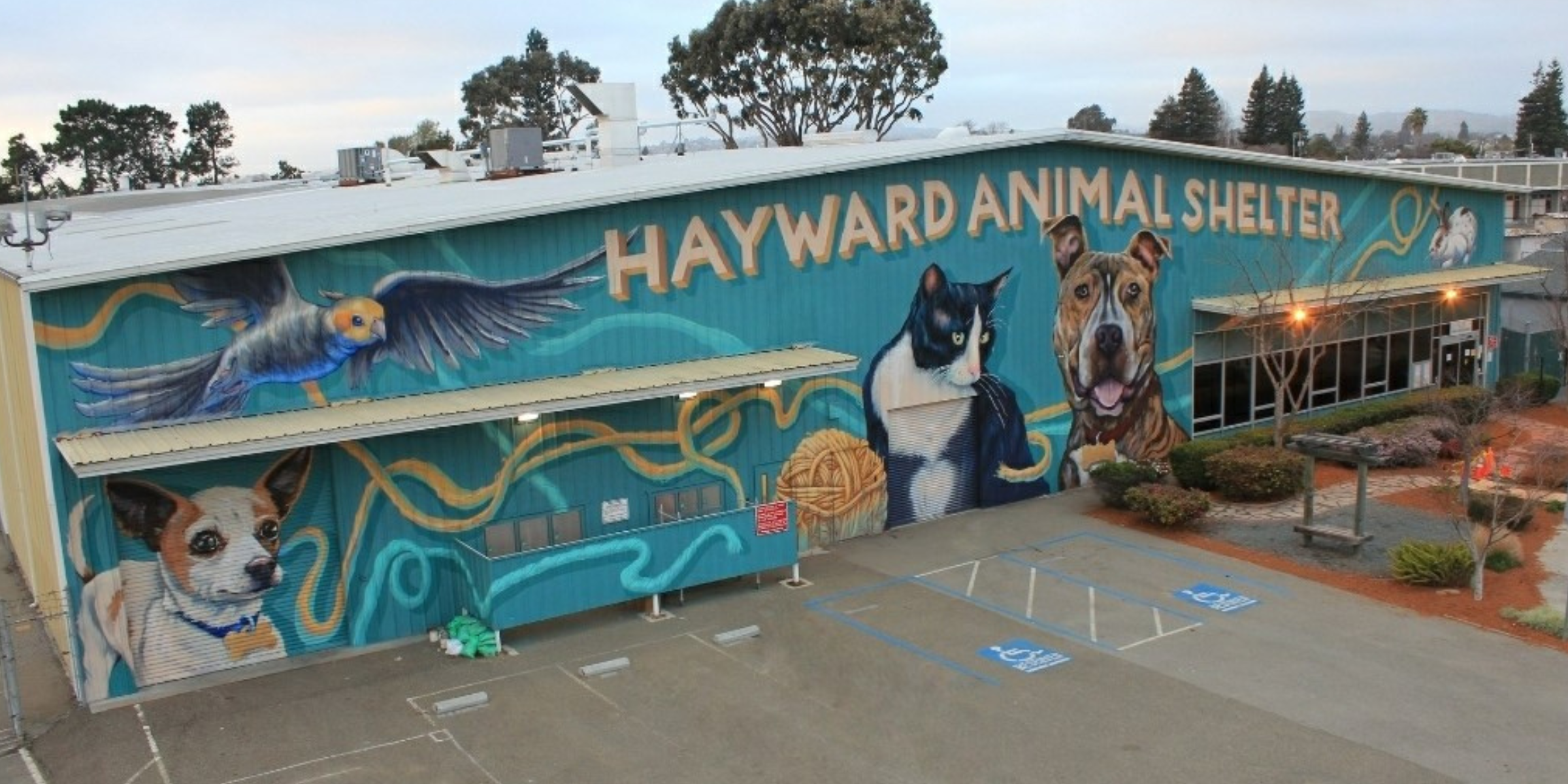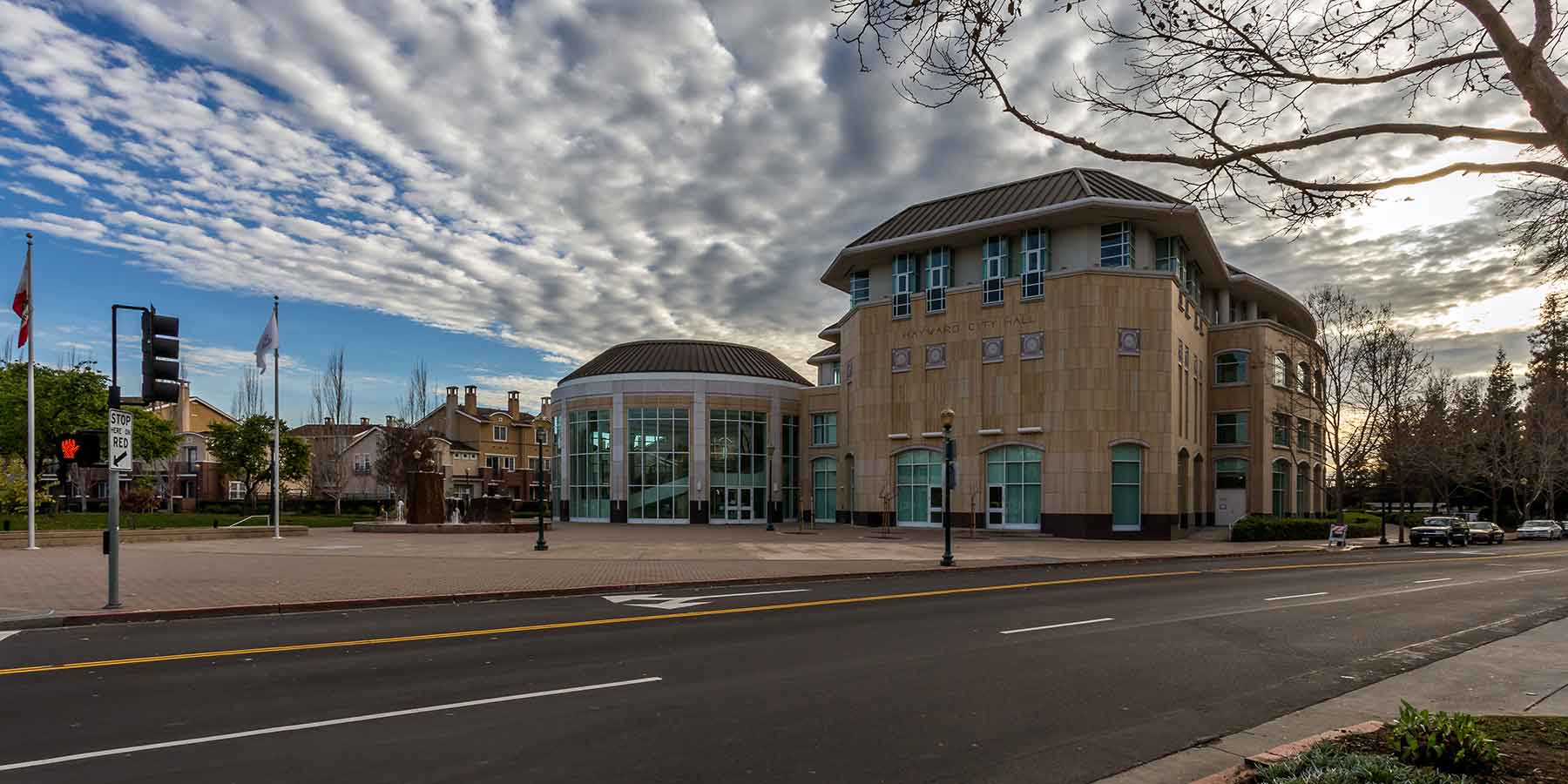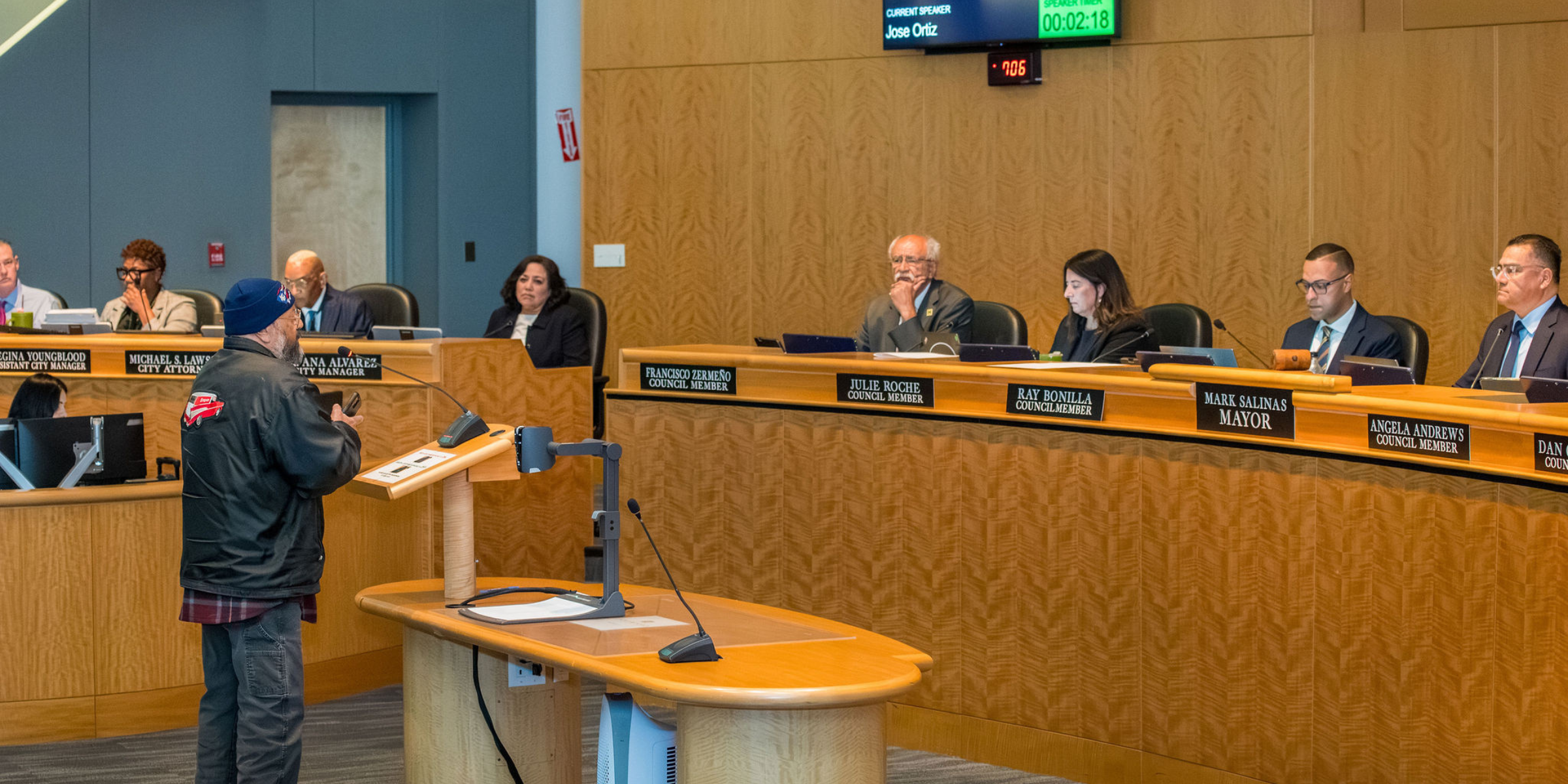Public Facilities and Services Element

Businesses and residents in Hayward are supported by a variety of public facilities and services. To sustain existing households and businesses and to accommodate future population and employment growth, water, wastewater, stormwater drainage, flood control, solid waste, energy, and telecommunications infrastructure will need to be improved, expanded, and maintained. Obtaining adequate funding for infrastructure and public facilities is also a key challenge and priority for the City of Hayward.
The Public Facilities and Services Element establishes goals and policies to guide the overall provision of public facilities and services in Hayward. The goals and policies address general public facilities and services, efficient municipal operations, water distribution, wastewater collection and disposal, stormwater drainage, flood control infrastructure, solid waste and recycling, energy utilities, and telecommunications. A number of the goals and policies also serve as Climate Action Plan actions, which are designed to reduce local greenhouse gas emissions.
The Public Facilities and Services Element contains goals and policies that indirectly and directly support other elements of the General Plan, including the Land Use and Community Character Element, the Economic Development Element, and the Health and Quality of Life Element.
Public Facilities and Services Goals:
PFS-1: Ensure the provision of adequate and efficient facilities and services that maintain service levels, are adequately funded, accessible, reliable, and strategically allocated.
The City of Hayward and other agencies and organizations maintain a variety of public facilities and provide many public services to meet the needs of residents and businesses, including water supply and delivery, wastewater collection and treatment, stormwater drainage and flood control, solid waste collection and recycling, energy distribution, and communications.Policies in this section guide the overall provision of public facilities and services in Hayward. Maintaining necessary levels of service with adequate funding for all facilities is paramount to meet the demands of existing and future residents and businesses.
PFS-1.1: Capital Improvement Program:
The City shall maintain the to ensure the implementation of the General Plan and the adequate and timely provision of public facility and municipal utility improvements.
PFS-1.2: Priority for Infrastructure:
The City shall give high priority in capital improvement programming to funding rehabilitation or replacement of critical infrastructure that has reached the end of its useful life or has capacity constraints.
PFS-1.3: Public Facility Master Plans:
The City shall maintain and implement public facility master plans to ensure compliance with appropriate regional, State, and Federal laws; the use of modern and cost-effective technologies and best management practices; and compatibility with current land use policy.
PFS-1.4: Development Fair Share:
The City shall, through a combination of improvement fees and other funding mechanisms, ensure that new development pays its fair share of providing new public facilities and services and/or the costs of expanding/upgrading existing facilities and services impacted by new development (e.g., water, wastewater, stormwater drainage).
PFS-1.5: Neighborhood Compatibility:
The City shall ensure that public facilities, such as utility substations, water storage and treatment plants, and pumping stations are located, designed, and maintained so that noise, light, glare, or odors associated with these facilities will not adversely affect nearby land uses. The City shall require these facilities to use building and landscaping materials that are compatible with or screen them from neighboring properties.
PFS-1.6: Public Facility Clustering:
The City shall promote the clustering of public and quasi-public facilities (e.g., schools, parks, libraries, child care facilities, community activity centers), the joint-use of these facilities, and agreements for sharing costs and operational responsibilities among public service providers.
PFS-1.7: Adaptive Infrastructure:
The City shall monitor expected impacts of climate change on the city’s infrastructure and services and make appropriate adaptive facility and service modifications and upgrades.
Goal PFS-2: Operate and function in a sustainable manner, use public revenues and resources efficiently, and provide professional, high-quality service to residents and businesses.
The City of Hayward manages and operates a variety of public and community services throughout the city. The City is facing increased pressure to deliver services with fewer resources and less money. At the same time, there are greater expectations for the City to operate and manage facilities in a sustainable manner by reducing energy and water consumption and the generation of waste. Policies in this section provide for high-quality and efficient services throughout the city. The City will encourage sustainability in municipal operations and facilities. Utility policies will improve the capacity and energy efficiency of the City’s infrastructure.
PFS-2.1: High-Quality Service:
The City shall continue to offer professional, high-quality service that meets the needs of residents and businesses.
PFS-2.2: Efficient, Cost Effective Operations:
The City shall continue to function efficiently in all its operations and activities and use revenues in a cost effective manner.
PFS-2.3: Sustainability Practices:
The City shall serve as a role model to businesses and institutions regarding purchasing decisions that minimize the generation of waste, recycling programs that reduce waste, energy efficiency and conservation practices that reduce water, electricity and natural gas use, and fleet operations that reduce gasoline consumption.
PFS-2.4: Sustainability Contracting:
When awarding contracts, professional service agreements, or grants to businesses or non-profit agencies, the City shall request proposals or applications to include information about the sustainability practices of the organization.
PFS-2.5: Alternative Fuels:
The City shall, wherever possible, require the use of alternative fuels in new services provided by City franchisees.
PFS-2.6: City Facilities Near Transit:
When making decisions about where to rent or build new City facilities, the City shall give preference to locations that are accessible to an existing public transit line or ensure that public transit links (e.g. bus lines) are extended to the new locations.
PFS-2.7: Energy Efficient Buildings and Infrastructure:
The City shall continue to improve energy efficiency of City buildings and infrastructure through implementation of the Municipal Green Ordinance, efficiency improvements, equipment upgrades, and installation of clean, renewable energy systems.
PFS-2.8: Technology Use:
The City shall continue to use communications technology to enhance the performance of internal City operations and the delivery of public services.
PFS-2.9: Financial Planning for Sustainability:
The City shall continue to maintain and implement its financial plan, which provides a plan for City goal setting in the budget process in implementing its policies, priorities, and programs.
Goal PFS-3: Maintain a level of service in the City's water system that meets the needs of existing and future development while improving water system efficiency.
About 95 percent of the City, including nearly all commercial and institutional development, is served by the Hayward Water System. All water supplies are received from the San Francisco Public Utilities Commission (SFPUC) Regional Water System. The remaining small portion of north Hayward is served by the East Bay Municipal Utility District (EBMUD).
The water supplied is delivered through the Hetch-Hetchy aqueducts, but also includes treated water produced by the SFPUC from its local watershed and facilities in Alameda County. The City receives water through two aqueducts along Mission Boulevard and Hesperian Boulevard. In addition, five water wells, certified by the California Department of Health Services for short duration emergency use only, are located within the city limits. Major water system projects in the near term focus on replacing and renovating existing water storage reservoirs to increase storage capacity and improve structural reliability. The City has also made extensive efforts to improve the seismic safetyof the water system, including seismic retrofits of several reservoirs and improvements to pipes at fault line crossings.
Policies in this section ensure existing and future residents a reliable water supply through the City’s Water Supply Agreement with the SFPUC, the City’s distribution system, and facilities within the EBMUD service area. Water conservation policies will be implemented by the City to increase water use efficiency and to address potential water shortages. Existing water infrastructure will be maintained and updated to improve structural reliability and improve seismic safety.
PFS-3.1: Water Distribution System Master Plan:
The City shall maintain and implement the Water Distribution System Master Plan.
PFS-3.2: Urban Water Management Plan:
The City shall maintain and implement the Water Management Plan, including water conservation strategies and programs, as required by the Water Management Planning Act.
PFS-3.3: Water Shortage Allocation Plan:
The City shall support implementation of the Water Shortage Allocation Plan, which distributes available water from the regional water system among San Francisco Public Utility Commission and wholesale customers in the event of a system-wide shortage of 20 percent or less.
PFS-3.4: Water Shortage Contingency Plan:
The City shall maintain and implement the Water Shortage Contingency Plan as necessary to address climate conditions or other water shortage emergencies.
PFS-3.5: Water System Reliability:
The City shall focus major water system projects on improving water system reliability, and shall replace or repair water lines that are leaking or otherwise meet the City’s criteria for replacement, when deemed financially feasible.
PFS-3.6: Exercise and Protect Water Rights:
The City shall exercise and protect its surface and ground water rights and entitlements in perpetuity.
PFS-3.7: Water Agency Participation:
The City shall continue to participate in the Bay Area Water Supply and Conservation Agency and purchase water from the San Francisco Public Utility Commission.
PFS-3.8: Water Treatment Capacity and Infrastructure:
In the event that San Francisco Public Utilities Commission is unable to provide water that meets drinking water standards, the City shall plan, secure funding for, and procure sufficient water treatment capacity and infrastructure to meet projected water demands.
PFS-3.9: High-Quality Service Provision:
The City shall provide water service that meets or exceeds State and Federal drinking water standards.
PFS-3.10: East Bay Municipal Utility District:
The City shall work with the East Bay Municipal Utility District to provide adequate water service to areas in the not served by the City.
PFS-3.11: Water Supply During Emergencies:
The City shall, to the extent feasible, maintain adequate water supply during emergencies. The City shall maintain emergency water connections with the Alameda County Water District and the East Bay Municipal Utility District in case of disruption of delivery from San Francisco Public Utility Commission and maintain emergency wells for short duration use in an emergency and ensure that wells meet primary drinking water standards.
PFS-3.12: Seismic Safety:
The City shall continue to improve the seismic safety of the water system, including seismic retrofits of reservoirs and improvements to pipes at fault line crossings.
PFS-3.13: New Development:
The City shall ensure that water supply capacity is in place prior to granting building permits for new development.
PFS-3.14: Water Conservation Standards:
The City shall comply with provisions of the State’s 20x2020 Water Conservation Plan (California Water Control Board, 2010).
PFS-3.15: Water Conservation Programs:
The City shall implement cost effective conservation strategies and programs that increase water use efficiency, including providing incentives for adoption of water efficiency measures Water conservation strategies may include a combination of financial incentives, legislative actions, and public education.
PFS-3.16: Recycled Water:
The City shall increase use of recycled water where appropriate, cost effective, safe, and environmentally sustainable. The City shall work with regional partners to encourage expansion of recycled water infrastructure.
PFS-3.17: Bay- Friendly Landscaping:
The City shall promote landscaping techniques that use native and climate appropriate plants, sustainable design and maintenance, water-efficient irrigation systems, and yard clipping reduction practices.
Goal PFS-4: Maintain a level of service in the City's wastewater collection and disposal system to meet the needs of existing and future development.
The City of Hayward owns and operates the wastewater collection and treatment system that serves almost all of the residential, commercial, and industrial users within the incorporated city limits, and limited portions of the adjacent unincorporated areas of Alameda County by contract. The City has separate sewage and storm water collection systems. The Hayward collection system includes about 320 miles of sewer mains, nine sewage lift stations, and 4.2 miles of force mains and treatment occurs at the City’s Water Pollution Control Facility (WPCF). The East Bay Dischargers Authority disposes of the treated wastewater from the city. The Oro Loma Sanitary District (OLSD) provides services to a small area in the northern portion of the City, as well as the community of Fairview, which is part of Hayward’s Planning area.
Policies in this section provide for reliable sewer service for all residents and businesses through a cooperative effort using the City’s wastewater collection and treatment system, Oro Loma Utility District facilities, and disposal service fromthe East Bay Dischargers Authority. Wastewater outflows will be minimized and capacity will be developed and maintained to improve sewer flows in areas where services are or will soon be deficient and to handle additional sewer flows from new development. Wastewater policies will also be implemented by the City to ensure sufficient treatment capacity and reliability of the Water Pollution Control Facility (WPCF).
PFS-4.1: Sewer Collection System Master Plan:
The City shall maintain and implement the Sewer Collection System Master Plan.
PFS-4.2: Water Pollution Control Facility Master Plan:
The City shall maintain and implement the Water Pollution Control Facility Master Plan.
PFS-4.3: Sewer Collection System - Minimization of Sanitary Sewer Overflows:
The City shall operate and maintain the sewer collection system to minimize the potential for sewer system overflows.
PFS-4.4: Water Pollution Control Facility Operation and Maintenance:
The City shall operate and maintain the WPCF to ensure that wastewater discharge meets all applicable NPDES permit provisions.
PFS-4.5: Coordinated Service:
The City shall work with the Oro Loma Sanitary District to provide adequate wastewater service to areas in the not served by the City.
PFS-4.6: Innovative and Efficient Operations:
The City shall strive to adopt innovative and efficient wastewater treatment technologies that are environmentally-sound.
PFS-4.7: Reduce Infiltration/Inflow:
The City shall develop and implement a plan to repair or replace underperforming wastewater facilities serving the community to remove excessive infiltration/inflow.
PFS-4.8: Seismic Safety:
The City shall continue to improve the seismic safety of it sewer collection and treatment facilities.
PFS-4.9: Service New and Existing Development:
The City shall ensure the provision of adequate wastewater service to all new development, before new developments are approved, and support the extension of wastewater service to existing developed areas where this service is lacking.
PFS-4.10: Wastewater Disposal:
The City shall work with the East Bay rs Authority to properly dispose of treated wastewater consistent with State and Federal laws.
PFS-4.11: Industrial Pretreatment:
The City shall enforce appropriate industrial pre-treatment standards and source control to prevent materials prohibited by Federal and State regulations from entering the wastewater system and to ensure compliance with the City’s local discharge limits. The City shall work with the business community to maintain and implement programs to ensure compliance with all Federal, State and local discharge requirements.
PFS-4.12: Renewal Energy:
The City shall support efforts to develop, enhance, and maintain clean, green and renewable energy systems at the Water Pollution Control Facility, including:
- Solar photovoltaic and solar hot water; and
- Methane recovery systems and digester gas combustion systems.
Goal PFS-5: Maintain an adequate level of service in the City's storm drainage system to accommodate runoff from existing and future development, prevent property damage due to flooding, and improve environmental quality.
The major storm drainage facilities within Hayward are owned and maintained by the Alameda County Flood Control and Water Conservation District (ACFCWCD) and include gravity pipe lines predominantly made of reinforced concrete, which discharge to underground storm drain lines or manmade open channels. Storm drain pipes smaller than 30 inches are generally owned by the City. The City has five pump stations that pump stormwater into stormwater collection systems and/or dry creeks immediately downstream, flowing into Mt. Eden and Old Alameda Creeks en route to San Francisco Bay. Much of Western Alameda County lies in a floodplain protected by the ACFCWCD. Most major flood control infrastructure in western Alameda County is 50 or 60 years old.
Policies in this section require construction of adequate storm drainage facilities. Stormwater policies ensure new drainage facilities are adequately sized and constructed, support coordinated efforts with the ACFCWCD in the development of major and regional stormwater facilities, and require preparation of watershed drainage plans where appropriate.Stormwater drainage facilities will also incorporate Low Impact Development techniques.
PFS-5.1: Accommodate New and Existing Development:
The City shall work with the Alameda County and Water Conservation District to expand and maintain major stormwater drainage facilities to accommodate the needs of existing and planned development.
PFS-5.2: Local Flooding:
The City shall identify and correct problems of localized flooding within the city. Where practical and economical, the City shall upgrade existing drainage facilities as necessary.
PFS-5.3: Watershed Drainage Plans:
The City shall require developers of proposed large development projects to prepare watershed drainage plans. plans shall define needed drainage improvements per City standards, estimate construction costs for these improvements, and be implemented through the and Control Program and Alameda Countywide Clean Water Program.
PFS-5.4: Green Stormwater Infrastructure:
The City shall encourage “green infrastructure” design and Low Impact Development (LID) techniques for stormwater facilities (i.e., using vegetation and soil to manage stormwater) to achieve multiple benefits (e.g., preserving and creating open space, improving runoff water quality).
PFS-5.5: Public Improvement Design:
The City shall design public improvements such as streets, parks, and plazas for retention and infiltration of stormwater by diverting urban runoff to bio-filtration systems, such as green scapes and implementing Low Impact Development (LID) techniques.
PFS-5.6: Grading Projects:
The City shall impose appropriate conditions on grading projects performed during the rainy season to ensure that silt is not conveyed to storm drainage systems.
PFS-5.7: Diversion:
The City shall require new development to be designed to prevent the diversion of stormwater onto neighboring parcels.
PFS-5.8: Enhance Recreation and Habitat:
The City shall require new stormwater drainage facilities to be designed to enhance recreation and habitat and shall work with HARD to integrate such facilities into existing parks and open space features.
PFS-5.9: Rainwater Harvesting:
The City shall encourage the use of rainwater harvesting facilities, techniques, and improvements where appropriate, cost effective, safe, and environmentally sustainable.
Goal PFS-6: Maintain flood control infrastructure to adequately protect life and property from flooding.
Much of Western Alameda County lies in a floodplain protected by the Alameda County Flood Control and Water Conservation District(ACFCWCD). The Hayward planning area spans across three flood protection zones that include natural creeks, improved creeks, earthen channels, concrete channels, and underground pipes.The three zones also include two drainage canals, eleven pump stations, and two reservoirs.
Policies in this section require construction of adequate flood protection facilities. Flood protection policies will also be implemented by the City to improve flood control infrastructure and control urban runoff. The City will work with the ACFCWCD in the development of major and regional stormwater facilities.
Related goals and policies in the Hazards Element address flood hazards and rising sea levels.
PFS-6.1: Interagency Levee Management:
The City shall work with Alameda County and Water Conservation District, State, and Federal agencies to ensure existing and new levees are adequate in providing flood protection.
PFS-6.2: Zone 3A Drainage Master Plan Study:
The City shall support implementation of the Alameda County and Water Conservation District Zone 3A Master Plan Study, which identifies improvement projects and expected maintenance activities to ensure 100-year flood protection in and around Hayward.
PFS-6.3: Funding for 200- Year Flood Protection:
The City shall continue to cooperate with Alameda County and Water Conservation District, State, and Federal agencies in securing funding to provide 200-year flood protection.
PFS-6.4: Floodplain Storage Maintenance:
The City shall encourage the preservation of urban creeks to maintain existing floodplain storage.
PFS-6.5: Levee Setbacks for New Development:
The City shall prohibit new development within a minimum distance of 50 feet of the landside toe of levees. Development may encroach within this 50-foot area provided that levee improvements are made to the standard levee section consistent with local, regional, State, and Federal standards.
PFS-6.6: Dedication of Levee Footprint:
The City shall require new development adjacent to a flood protection levee to dedicate the levee footprint in fee to the Alameda County and Water Conservation District or the appropriate responsible agency.
Goal PFS-7: Minimize the generation of solid waste, increase recycling, and provide for the collection and disposal of solid waste.
Policies in this section support a wide range of programs to reduce and divert waste from landfill, provide for increased recycling opportunities, increase participation in recycling services offered residents and businesses, support the recycling of construction debris, and encourage home composting. These policies are consistent with Hayward’s desire to promote sustainability because recycling reduces greenhouse gas emissions through energy savings, and reduced need for landfills. The City will continue to work with the Alameda County Waste Management Authority to reach County-wide diversion targets.
PFS-7.1: Mandatory Collection:
The City shall continue to require weekly solid waste collection throughout the city.
PFS-7.2: Adequate Service:
The City shall monitor its solid waste and recycling services franchisee to ensure that services provided are adequate to meet the needs of the community and to meet the provisions of the City’s Franchise Agreement.
PFS-7.3: Landfill Capacity:
The City shall continue to coordinate with the Alameda County Waste Management Authority to ensure adequate landfill capacity in the region for the duration of the contract with its landfill franchisee.
PFS-7.4: Solid Waste Diversion:
The City shall comply with State goals regarding diversion from landfill, and strive to comply with the provisions approved by the Alameda County Waste Management Authority.
PFS-7.5: Municipal Waste Reduction:
The City shall reduce municipal waste generation by continuing to employ a wide range of innovative techniques, including electronic communications to reduce paper usage and buying products with less packaging and in bulk, where feasible.
PFS-7.6: Municipal Reuse:
The City shall reduce municipal waste disposed by continuing to reuse equipment to prolong their useful life.
PFS-7.7: Municipal Collection of Recyclables and Organics:
The City shall continue to require its franchisee to arrange for regular collection of recyclables and organics from all municipal facilities.
PFS-7.8: Recycling Collection at City Facilities and Parks:
The City shall continue to require its franchisee to provide outdoor recycling collection containers at, and services to, all City parks and related facilities.
PFS-7.9: City Contract:
The City shall continue to implement the Environmentally Friendly Preferred Purchasing Program by requiring City contractors to use best management practices (e.g., waste prevention, salvage and reuse, recycling and reusing) to maximize diversion of waste from landfills.
PFS-7.10: Recycled Products or Processes for Capital Projects:
The City shall implement the use of recycled products or recycling processes whenever possible as part of any capital project.
PFS-7.11: Disposable, Toxic, or Non-Renewable Products:
The City shall reduce the use of disposable, toxic, or nonrenewable products in City operations.
PFS-7.12: Construction and Demolition Waste Recycling:
The City shall require demolition, remodeling and major new development projects to salvage or recycle asphalt and concrete and all other non-hazardous construction and demolition materials to the maximum extent practicable.
PFS-7.13: Residential Recycling:
The City shall encourage increased participation in residential recycling programs, and strive to comply with the recycling provisions approved by the Alameda County Waste Management Authority Board. The City shall work with StopWaste.org to monitor participation in residential recycling programs and educate the community regarding actual composition of waste sent to landfills.
PFS-7.14: Commercial Recycling:
The City shall encourage increased participation in commercial and industrial recycling programs, and strive to comply with the recycling provisions approved by the Alameda County Waste Management Authority Board. The City shall work with StopWaste.org to provide technical assistance to businesses to implement mandatory recycling.
PFS-7.15: Yard Clippings Reduction:
The City shall encourage residents to reduce yard clippings through at-home composting or use the green waste collection service provided by the City’s franchisee.
PFS-7.16: Organics Collection:
The City shall encourage residents and businesses to separate for collection food and food-soiled paper using organics collection services provided by the City’s franchisee.
PFS-7.17: Waste-to-Energy Generation Systems:
The City shall advocate for waste management strategies that aim to maximize the value of solid waste by using waste-to-energy generation systems.
PFS-7.18: E-Waste Disposal:
The City shall encourage residents and businesses to properly dispose of their e-waste at permitted facilities.
PFS-7.19: Regional Coordination:
The City shall coordinate with and support regional efforts to develop and implement effective waste management strategies.
PFS-7.20: Food Scapes Collection:
The City shall promote and expand the food scraps collection program for single-family homes to minimize organic waste in landfills.
PFS-7.21: Mandatory Recycling:
The City shall implement mandatory recycling for commercial and multifamily uses and work with StopWaste.org to increase participation in this program.
PFS-7.22: Maximize Solid Waste Value:
The City shall advocate for waste management strategies that maximize the useful value of solid waste, such as using landfill gas to generate electricity.
PFS-7.23: Consumption Reduction:
The City shall education the community about the benefits of reducing overall consumption.
Goal PFS-8: Ensure the provision of adequate gas and electric services to Hayward residents and businesses, and ensure energy facilities are constructed in a fashion that minimizes their impacts on surrounding development and maximizes efficiency.
The Pacific Gas and Electric Company (PG&E) provides electrical and natural gas service to the Hayward Planning Area. PG&E maintains three major transmission lines running west to east across Alameda county to substations in Hayward, San Mateo, and Fremont. There are also several renewable energy facilities (e.g., Water Pollution Control FacilityCogeneration System, CSU East Bay Fuel Cell Station, and the Hayward Wastewater Solar Facility) and many smaller onsite renewable energy facilities on .
Policies in this section support the maintenance and expansion of city electricity and gas service. Utility providers will ensure that transmission facilities incorporate safety features and the latest technological advancement.The City will require utility facilities to reduce habitat and visual impacts, and will encourage utility rights-of-way to be used as open space.
PFS-8.1: Electricity and Natural Gas Service
The City shall continue to work closely with energy providers (e.g., PG&E) to ensure that adequate electricity and natural gas services are available for existing and newly developing areas.
PFS-8.2: Utility Providers:
The City shall encourage utility providers to provide efficient, reliable, affordable, and state-of-the-art service, and shall promote technological improvements and upgrading of utility services.
PFS-8.3: Coordination with Utility Providers:
The City shall coordinate with energy providers (e.g., PG&E)in the siting and design of gas and electric facilities to minimize environmental, aesthetic, and safety impacts.
PFS-8.4: Safe Utility Lines:
The City shall work with regulators and energy providers (e.g., PG&E) to regularly monitor, evaluate, and maintain the safety of utility facilities (e.g., gas pipelines and electric lines and transformers). Where facilities are found to be a potential safety concern,especially those that could be impacted by seismic events, the City shall support utility provider efforts to repair and/or replace the affected facilities.
PFS-8.5: Undergrounding New Utility Lines:
The City shall require that all new utility lines constructed as part of new development projects are installed underground or, in the case of transformers, pad-mounted.
PFS-8.6: Undergrounding Existing Utility Lines:
The City shall encourage the undergrounding of existing overhead facilities.
PFS-8.7: Utility Line Maintenance:
The City shall encourage energy providers (e.g., PG&E) to maintain and repair gas pipelines and electric utility lines, both overhead and underground) to ensure reliable service and limit service disruptions. The City shall inform energy providers of upcoming roadway or other public projects that provide opportunities to inspect or repair underground utility lines.
PFS-8.8: Renewable Energy Integration:
The City shall encourage energy providers (e.g., PG&E) to offer their support and assistance in integrating individual renewable energy systems (e.g., solar systems) into the electricity grid.
PFS-8.9: Joint Use:
The City shall ensure that PG&E rights-of-way are considered for use as public or private open space, trails, parkland, community gardens, or other compatible passive recreational uses.
Goal PFS-9: Encourage state-of-the-art technology and telecommunication services for households, businesses, institutions, and public agencies throughout the city toconnect Haywardresidents to the City, nation, and world.
Within the city of Hayward all residents have access to wireline or wireless providers. About 97 percent of the population has access to two or more wireline providers. All Hayward residents have access to five or more wireless providers and nearly all have access to six providers. Hayward residents generally have better access to DSL, cable, and wireless technology as compared to the nation. The City of Hayward operates a free Wi-Fi network in the Downtown area. The City of Hayward has installed two major fiber optic routes. The existing routes currently serve the city’s public and quasi-public areas and major industrial corridor.
Policies in this section encourage a wide range of innovative telecommunications systems and services to attract and retain state-of-the-art businesses citywide, provide information and communication access to all residents, and facilitate public education. Telecommunication systems should be incorporated into public buildings and services, as well as into large-scale planned communities and office and commercial projects, to increase the accessibility of information. Telecommunication infrastructure should be designed to be compatible with adjacent uses and to minimize visual impacts.
PFS-9.1: Access and Availability:
The City shall work with service providers to ensure access to and availability of a wide range of state-of-the-art telecommunication systems and services for households, businesses, institutions, public spaces, and public agencies throughout the city.
PFS-9.2: Improve Facilities and Service:
The City shall work with service providers to expand service to areas that are not served by telecommunication technologies.
PFS-9.3: Co-Location:
The City shall encourage compatible co-location of telecommunication facilities and shall work with service providers to site telecommunications facilities on City-owned property and public right-of-ways.
PFS-9.4: Incorporation into Public Places:
The City shall establish requirements for the incorporation and accessibility of state-of-the-art, attractive telecommunication systems and services for public use in public buildings and support the development of internet-connected informational kiosks in public places and streetscapes.
PFS-9.5: New Developments:
The City shall establish requirements for the installation of state-of-the-art internal telecommunications technologies in new planned developments and office and commercial developments.
PFS-9.6: Fiber Optic Cable Access:
The City shall support the extension of and connections to fiber optic telecommunications cables.
PFS-9.7: Development and Extension of Fiber Optic Network:
The City shall encourage the development and extension of the fiber optic system to support the City’s fiber optic network.
PFS-9.8: Wireless Hot Spots:
The City shall encourage the installation of public use wireless network “hot spots” throughout the city.
PFS-9.9: Downtown Wireless:
The City shall maintain and expand the coverage and bandwidth of the Downtown wireless network, which provides free wireless data service to residents, businesses, and visitors in and around Downtown.
PFS-9.10: Infrastructure for Telecommuting:
The City shall encourage the development of state-of-the-art communication infrastructure in appropriate City facilities to support telecommuting.








